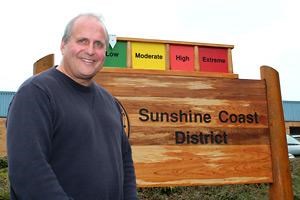A name change for the forestry office on Duncan Street in Powell River reflects the evolution of a provincial ministry.
The provincial government created the ministry of natural resource operations in late 2010. In March 2011, Premier Christy Clark merged it with the ministry of forests and lands, creating the ministry of forests, lands and natural resource operations. The purpose of the reorganization was to improve the capacity of the government to address the cumulative impact of multiple resources, as well as to create one land manager.
For the Sunshine Coast Forest District, the reorganization meant a new name, Sunshine Coast District, and new duties for staff.
Mark Anderson was named district manager in August 2011. He explained the ministry realignment was intended to capture the benefits of joining resource agencies by creating efficiencies. “It made no sense to have several different government officials making trips to Okeover Inlet at different times for different reasons,” he said. “Government needed to find different ways of collaborating and prioritizing
business to save money.”
District boundaries still stretch from Howe Sound in the south to Bute Inlet in the north. The district allowable cut is approximately 1.1 million cubic metres, not including tree farm licences, such as the one held by Western Forest Products.
The district office continues to provide traditional forestry functions, such as determining annual harvest levels, planning and permitting. In addition, many staff have been trained in different functions to support all of the government’s responsibilities on the land.
Staff do more multi-tasking, Anderson said. “As they’re out in the field, they may be checking forestry, mining or land permits,” he said.
As was experienced across the resource sector during the global downturn in the economy, through attrition the Sunshine Coast District staff was reduced by approximately 30 per cent over the past three to four years. Currently, the Powell River office has 35 technical, professional and administrative staff responsible for numerous functions, including selling timber in the BC Timber Sales program, engineering local backcountry roads and bridges and inspecting for revenue and environmental risks. The tenures section handles planning, permitting and land activities, as well as consultation with first nations.
In addition, staff monitor forest health issues and do ongoing evaluations of district development activities through the forest and range evaluation program, which Anderson described as government’s commitment to check the results of activities on the land base to ensure laws are working.
The office is also a Front Counter BC portal, which provides access to all permitting on Crown land, including commercial development, mining, water authorization and environmental permits. “It’s for anyone who wants to apply for Crown land activities,” said Anderson. “We can offer assistance at the office.”
The district has appointed a lands officer for any land permitting questions, Anderson added. Examples of applications for permits range from gravel pits to golf courses to clean energy projects, as well as forestry.
Currently, Anderson makes decisions on forestry permits and in the near future, he will be handling some of the land permitting decisions. Some larger projects will still be decided in the Lower Mainland.
The forest sector is now picking up Anderson said. “Last year in Powell River, logging activity provided an important boost to our local economy,” he said. “Our road and recreational infrastructure is getting better each year, thanks to our local resource managers and community advocates.”
The office is running a student program again this summer to support local high school students, Anderson said, and recently, it has filled part-time positions to help meet its challenges. “These are all good signs,” he said.



